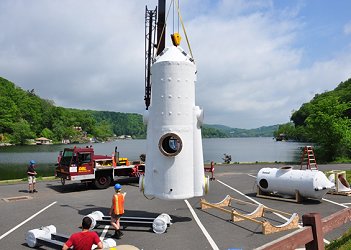1. Two new Layer Aeration towers after delivery to the Washington Boat Launch.
2. LWTF Executive Director Tom McGowan (left) being briefed by limnologist Dr. Robert Kortmann in front of the larger of the two new Layer Aeration Systems.
3. The larger Layer Aeration System at the Washington boat launch being lifted into position for towing to Arrow Point.
4. One of the new systems arriving at its new home east of Arrow Point.
The LWTF Board of Directors viewed a presentation in December 2014 by its chief limnologist, Dr. Robert Kortmann, regarding the potential benefits of converting the land-based hypolimnetic withdrawal system on Arrow Point (also known as the "Frost Site") to an in-lake system similar to the Layer Aeration towers that currently operate in the New Preston basin of the lake. After much discussion and analysis of the costs and potential benefits, the Board voted to implement this conversion.
Two new Layer Aeration Systems were ordered and delivered on May 28, 2015. They have been hooked up to a new compressor pump and are now operational. The larger of the new Layer Aeration towers is submerged on the east side of Arrow Point and the smaller tower is located on the shallower west side of the point. Their positions are made evident by the bubbling of released air, similar to the systems at the New Preston end of the lake.
The previous Frost Site complex took water from the east side of Arrow Point and channeled it through a series of concrete baffles, removing nutrients and aerating the water before returning it on the west side of the point. The system was installed in the early 1980s and had an anticipated useful lifespan of 25 years. Although largely responsible for water quality improvements over that time, those benefits have levelled off and maintenance costs increased rapidly. In addition, Dr. Kortmann stated that the Task Force has shifted its emphasis to a more sophisticated water management strategy that requires timing and water-level adjustments beyond the capability of the Frost Site.
Proposals under consideration for the Frost Site's concrete structure include the construction of solar panels to power the entire system and/or the possibility of nurturing the growth of zooplankton for possible re-introduction to the water. Zooplankton eat algae and therefore have a positive effect on water clarity.





